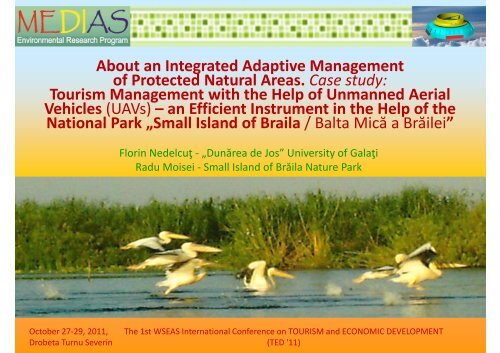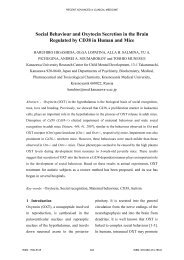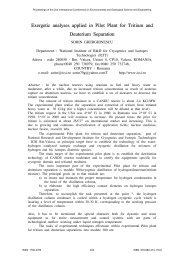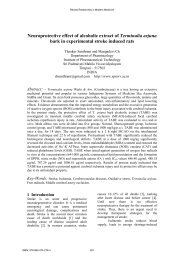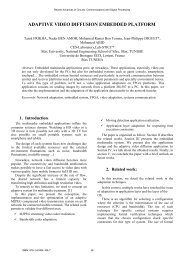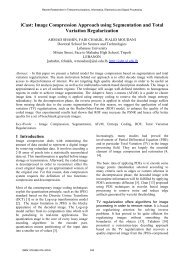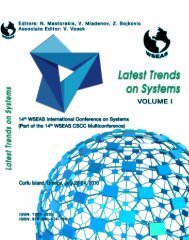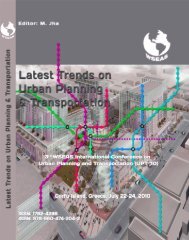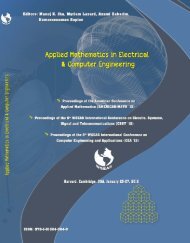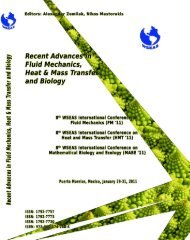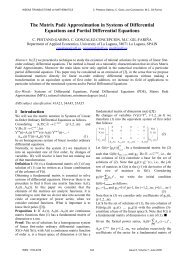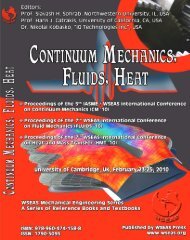TED11- final - Nedelcut - UAVs and the management of ... - Wseas.us
TED11- final - Nedelcut - UAVs and the management of ... - Wseas.us
TED11- final - Nedelcut - UAVs and the management of ... - Wseas.us
You also want an ePaper? Increase the reach of your titles
YUMPU automatically turns print PDFs into web optimized ePapers that Google loves.
INTRODUCTION Braila County <strong>and</strong> <strong>the</strong> axes <strong>of</strong> a s<strong>us</strong>tainable tourism <strong>UAVs</strong> today & Civil applications <strong>of</strong> <strong>the</strong> <strong>UAVs</strong> Small Isl<strong>and</strong> <strong>of</strong> Braila Nature Park <strong>UAVs</strong> <strong>and</strong> <strong>the</strong> <strong>management</strong> <strong>of</strong> protected areas - Case Study Concl<strong>us</strong>ionsOctober 27-29, 2011,Drobeta Turnu SeverinThe 1st WSEAS International Conference on TOURISM <strong>and</strong> ECONOMIC DEVELOPMENT(TED '11)2
Brăila countyBalneal tourismThe largest sapropelic mud reserve in Europe (4 health resorts):Lacu Sărat, Câineni Băi, Movila Miresii, Balta AlbăOctober 27-29, 2011,Drobeta Turnu SeverinThe 1st WSEAS International Conference on TOURISM <strong>and</strong> ECONOMIC DEVELOPMENT(TED '11)8
Brăila countyEcologic tourismEcologic tourismin <strong>the</strong> National ParkSmall Isl<strong>and</strong> <strong>of</strong> Braila / Balta Mică a BrăileiOctober 27-29, 2011,Drobeta Turnu SeverinThe 1st WSEAS International Conference on TOURISM <strong>and</strong> ECONOMIC DEVELOPMENT(TED '11)9
<strong>UAVs</strong> nowadays<strong>UAVs</strong> are Unmanned Aerial Vehicles (i.e. remotely piloted),They were initially developed by militaries, but now <strong>the</strong>re are manycivil <strong>UAVs</strong>, with morediverse <strong>and</strong> wide-rangedapplications.October 27-29, 2011,Drobeta Turnu SeverinThe 1st WSEAS International Conference on TOURISM <strong>and</strong> ECONOMIC DEVELOPMENT(TED '11)10
The civil applications <strong>of</strong> <strong>the</strong> <strong>UAVs</strong>With an adequate equipment,an UAV can monitor large areasover l<strong>and</strong> or water.During its missions it can helpwith firefighting in forests or inplains, or detect unauthorizedhuman activities such as illegaldischarges <strong>of</strong> toxic substancesover <strong>the</strong> soil, water, or in air.The MEDIAS project presented here attains to providesolutions for monitoring environment parameters for largeareas, <strong>the</strong>reby preserving <strong>the</strong>ir stat<strong>us</strong> as unique nature oasis.October 27-29, 2011,Drobeta Turnu SeverinThe 1st WSEAS International Conference on TOURISM <strong>and</strong> ECONOMIC DEVELOPMENT(TED '11)11
The civil applications <strong>of</strong> <strong>the</strong> <strong>UAVs</strong>The civil applications <strong>of</strong> <strong>the</strong> <strong>UAVs</strong> rely on <strong>the</strong>ir possibility toaccomplish missions with a great diversity.Besides <strong>the</strong> measurement <strong>of</strong> <strong>the</strong> environmental parameters <strong>and</strong>monitoring <strong>of</strong> <strong>the</strong> nature reserves as a non-polluting UAV(e.g. MEDIAS) could accomplish, <strong>the</strong> civil <strong>UAVs</strong> shall be able tocarry out a large variety <strong>of</strong> missions such as:• Fire <strong>and</strong> Rescue,• Government,• Agriculture• Energy Sector, Forestry <strong>and</strong> Fisheries,• Communications <strong>and</strong> Broadcasting,• Earth Observation <strong>and</strong> Remote SensingOctober 27-29, 2011,Drobeta Turnu SeverinThe 1st WSEAS International Conference on TOURISM <strong>and</strong> ECONOMIC DEVELOPMENT(TED '11)12
The civil applications <strong>of</strong> <strong>the</strong> <strong>UAVs</strong>5 major requirements for <strong>the</strong> UAVWhen we had to design this UAV for Environmental Surveillance<strong>and</strong> Parameters Monitoring, we had in mind five majorrequirements for <strong>the</strong> vehicle, as:1. To create a non-polluting vehicle,2. To obtain a maximum <strong>of</strong> autonomy(hours & km),3. To have <strong>the</strong> possibility to hover over an designated area,4. To have VTOL (Vertical Take-Off <strong>and</strong> L<strong>and</strong>ing) capabilities,beca<strong>us</strong>e a plane is dependent <strong>of</strong> a long l<strong>and</strong>ing-strip.5. To design a more efficient propulsion system.October 27-29, 2011,Drobeta Turnu SeverinThe 1st WSEAS International Conference on TOURISM <strong>and</strong> ECONOMIC DEVELOPMENT(TED '11) 13
The civil applications <strong>of</strong> <strong>the</strong> <strong>UAVs</strong>Missions to be carried outCharacteristics <strong>of</strong> <strong>the</strong> missions to be performedThe first tasks for <strong>the</strong> experimental model within <strong>the</strong> project willbe ei<strong>the</strong>r:• Photo- or video-recordings with scientific purposesor• Real time monitoring <strong>of</strong> <strong>the</strong> nature reserves <strong>and</strong> <strong>of</strong> <strong>the</strong> areasfound within <strong>the</strong> range <strong>of</strong> <strong>the</strong> remote control.An example <strong>of</strong> such miniaturized systems for collecting<strong>and</strong> transmitting data are:• a portable meteorological station,• a camera (visible / infrared surveillance camera) or• a <strong>the</strong>rmal imaging system.October 27-29, 2011,Drobeta Turnu SeverinThe 1st WSEAS International Conference on TOURISM <strong>and</strong> ECONOMIC DEVELOPMENT(TED '11) 14
The s<strong>us</strong>tentation <strong>and</strong> propulsioncomponents <strong>of</strong> <strong>the</strong> MEDIAS UAVAlso in Romania, in 2008, anacademic consortium, withresearchers from Galaţi, Iaşi <strong>and</strong>Bacău universities, coordinated by<strong>the</strong> speaker, obtained, for <strong>the</strong>researches on Co<strong>and</strong>ă effect, anational grant (32123/CNMP/2008).According <strong>the</strong> contract, this newUAV, named MEDIAS, had to be in<strong>the</strong> same time a modern <strong>and</strong>a nonpolluting aerial vehicle, easy to maneuver <strong>and</strong> safe to <strong>the</strong>environment <strong>and</strong> people.Our Co<strong>and</strong>ă UAV has, as a civil mission, to survey <strong>and</strong> protect <strong>the</strong>natural environment, as nature reserves or national parks are.October 27-29, 2011,Drobeta Turnu SeverinThe 1st WSEAS International Conference on TOURISM <strong>and</strong> ECONOMIC DEVELOPMENT(TED '11) 15
The civil applications <strong>of</strong> <strong>the</strong> <strong>UAVs</strong>MEDIAS projectThe MEDIAS project is a VTOL UAVwith a hybrid design.Tridimensional model<strong>of</strong> <strong>the</strong> MEDIAS UAVAlongside <strong>the</strong>se features, optionalconversion & <strong>us</strong>e <strong>of</strong> solar energywill compete at increasing <strong>the</strong>UAV’s mission autonomy.October 27-29, 2011,Drobeta Turnu SeverinImages recorded withan on-board camera(w/o stabilization)The 1st WSEAS International Conference on TOURISM <strong>and</strong> ECONOMIC DEVELOPMENT(TED '11) 16
The civil applications <strong>of</strong> <strong>the</strong> <strong>UAVs</strong>Missions to be carried outBesides <strong>the</strong> measurement <strong>of</strong> environmental parameters, <strong>the</strong>MEDIAS UAV described previo<strong>us</strong>ly will be able to carry out alarge variety <strong>of</strong> missions such as:• Wildlife inventory <strong>and</strong> species conservation, especially inmountains or wetl<strong>and</strong>s,• Forestry or fishery inspection,• Forest <strong>and</strong> crop disease <strong>management</strong>,• Forest <strong>and</strong> crop fire detection <strong>and</strong> firefighting <strong>management</strong>,• Monitoring <strong>of</strong> natural disasters (water flows, avalanches, oilspill tracking) etc...October 27-29, 2011,Drobeta Turnu SeverinThe 1st WSEAS International Conference on TOURISM <strong>and</strong> ECONOMIC DEVELOPMENT(TED '11) 17
Small Isl<strong>and</strong> <strong>of</strong> Braila (SIB)Biodiversity MagnitudeSecondly after <strong>the</strong> Danube Delta Biosphere Reserve(whichin a world top <strong>of</strong> biodiversity magnitude in those protectedareas holds <strong>the</strong> third position after <strong>the</strong> Great Barrier Reef<strong>and</strong> Galapagos Isl<strong>and</strong>s), SIB holds <strong>the</strong> highest bio diversityamong <strong>the</strong> 29 national<strong>and</strong> nature parks in Romania.October 27-29, 2011,Drobeta Turnu SeverinThe 1st WSEAS International Conference on TOURISM <strong>and</strong> ECONOMIC DEVELOPMENT(TED '11)18
<strong>UAVs</strong> <strong>and</strong> <strong>the</strong> <strong>management</strong> <strong>of</strong>protected areas - Case StudyThe eco – touristic potential for <strong>the</strong> buffer areas (<strong>the</strong> 7 big isl<strong>and</strong>sin SIB) <strong>and</strong> for <strong>the</strong> full protection areas, has been calculated atapproximately 8.500 visitors each year for an average period <strong>of</strong>5 days <strong>and</strong> a volume <strong>of</strong> 42.500 touristic days.Concurrently with <strong>the</strong> incl<strong>us</strong>ion <strong>of</strong> <strong>the</strong> 3 areas <strong>of</strong> s<strong>us</strong>tainabledevelopment <strong>of</strong> human activities in SIB, as frequently visitedby 90% <strong>of</strong> sportive fishermen (who, in 2007 have stood for73,6% <strong>of</strong> <strong>the</strong> overall visitors), we estimate <strong>the</strong> touristicpotential <strong>of</strong> SIB to be 25 tho<strong>us</strong><strong>and</strong> visitors each year (16.500tourists /year in <strong>the</strong> Area <strong>of</strong> S<strong>us</strong>tainable Development <strong>of</strong>Human Activities + 8.500 tourists /year in <strong>the</strong> 7 Areas <strong>of</strong>S<strong>us</strong>tainable Management).October 27-29, 2011,Drobeta Turnu SeverinThe 1st WSEAS International Conference on TOURISM <strong>and</strong> ECONOMIC DEVELOPMENT(TED '11)19
<strong>UAVs</strong> <strong>and</strong> <strong>the</strong> <strong>management</strong> <strong>of</strong>protected areas - Case StudyWhen developing a s<strong>us</strong>tainable tourism in SIB,one requires <strong>the</strong> adoption <strong>of</strong> a<strong>management</strong> which shallsimultaneo<strong>us</strong>ly combine<strong>the</strong> following :• Ecologic support capacity,• Economic support capacity,• Social support capacity,• Psychological support capacity.The economic, social <strong>and</strong> psychologicalsupport capacities shall be calculated upon <strong>the</strong>following review <strong>of</strong> <strong>the</strong> Management Plan.October 27-29, 2011,Drobeta Turnu SeverinThe 1st WSEAS International Conference on TOURISM <strong>and</strong> ECONOMIC DEVELOPMENT(TED '11)20
<strong>UAVs</strong> <strong>and</strong> <strong>the</strong> <strong>management</strong> <strong>of</strong>protected areas - Case StudyIn <strong>the</strong> case <strong>of</strong> those full protection areas, <strong>the</strong> Scientific Councilhas approved in <strong>the</strong> meeting from November 2005:• An ecologic support capacity for <strong>the</strong> tourism activity <strong>of</strong>15 tourists per day - in <strong>the</strong> Full Protection Area Fundu Mare• An ecologic support capacity for <strong>the</strong> tourism activity <strong>of</strong>25 tourists / day in <strong>the</strong> Full Protection Area Egreta,• An ecologic support capacity for <strong>the</strong> tourism activity <strong>of</strong>20 tourists / day in <strong>the</strong> Full Protection Area Cucova.October 27-29, 2011,Drobeta Turnu SeverinThe 1st WSEAS International Conference on TOURISM <strong>and</strong> ECONOMIC DEVELOPMENT(TED '11)21
<strong>UAVs</strong> <strong>and</strong> <strong>the</strong> <strong>management</strong> <strong>of</strong>protected areas - Case StudyThe types <strong>of</strong> tourism which may be carried out in SIB are:• Eco - tourism (fishing sports also included here),• Agro – tourism,• Scientific tourism• Educational tourism.The forms <strong>of</strong> tourism allowed in SIB are:• Nautical tourism, as practiced both individually (by kayak), aswell as in group (by oared boats),• Equestrian tourism,• Cycle – tourism,• Pedestrian tourism.October 27-29, 2011,Drobeta Turnu SeverinThe 1st WSEAS International Conference on TOURISM <strong>and</strong> ECONOMIC DEVELOPMENT(TED '11)22
<strong>UAVs</strong> <strong>and</strong> <strong>the</strong> <strong>management</strong> <strong>of</strong>protected areas - Case StudyAccording to SIB Visiting Strategy, submitted inJanuary 2010 with <strong>the</strong> Intermediate Body inGalati, by means <strong>of</strong> <strong>the</strong> finance petition atPOS-1, in SIB tourists’ access is regulatedas follows:i. Tourist Zone I corresponds to <strong>the</strong>2 strictly protected areas;ii. Tourist Zone II corresponds to <strong>the</strong>7 s<strong>us</strong>tainable <strong>management</strong> areas+ <strong>the</strong> 8 full protection areasiii. Tourist Zone III corresponds to <strong>the</strong> area fors<strong>us</strong>tainable development <strong>of</strong> human activities.October 27-29, 2011,Drobeta Turnu SeverinThe 1st WSEAS International Conference on TOURISM <strong>and</strong> ECONOMIC DEVELOPMENT(TED '11)23
30 arguments in favor <strong>of</strong> <strong>us</strong>ing <strong>UAVs</strong> inSIB <strong>management</strong>Integrated <strong>and</strong> adaptive <strong>management</strong> <strong>of</strong> SIB, with <strong>the</strong>help <strong>of</strong> <strong>UAVs</strong>, st<strong>and</strong>s on dozens <strong>of</strong> arguments.1.SIB has <strong>the</strong> biggest length (62 km) among <strong>the</strong>Romanian nature parks,2.There are no human settlements within SIB,3.There is an intense fragmentation <strong>of</strong> <strong>the</strong> l<strong>and</strong>environment, due to <strong>the</strong> surrounding water areas,4.An imperio<strong>us</strong> need for monitoring <strong>the</strong> spectaculardynamics <strong>of</strong> <strong>the</strong> meadow micro – l<strong>and</strong> surface,5.The annual alternations between <strong>the</strong> water <strong>and</strong> l<strong>and</strong>environment.October 27-29, 2011,Drobeta Turnu SeverinThe 1st WSEAS International Conference on TOURISM <strong>and</strong> ECONOMIC DEVELOPMENT(TED '11) 24
30 arguments in favor <strong>of</strong> <strong>us</strong>ing <strong>UAVs</strong> inSIB <strong>management</strong>6. SIB enjoys a three – sided legal stat<strong>us</strong>:i. At <strong>the</strong> national level: SIB was declarednature park (by virtue <strong>of</strong> Law no. 5/2000),ii. At <strong>the</strong> global level: SIB is declared to be aRamsar site (a wetl<strong>and</strong> <strong>of</strong> an internationalrelevance – as <strong>of</strong> June 2001),iii. At <strong>the</strong> European level: SIB is declared to bea ”Nature 2000 site”, as <strong>of</strong> December 2007,both as an Area <strong>of</strong> Birds <strong>and</strong> FaunaProtection (ROSPA0005), <strong>and</strong> as a Site <strong>of</strong>Community Importance (ROSCI0006).October 27-29, 2011,Drobeta Turnu SeverinThe 1st WSEAS International Conference on TOURISM <strong>and</strong> ECONOMIC DEVELOPMENT(TED '11) 25
30 arguments in favor <strong>of</strong> <strong>us</strong>ing <strong>UAVs</strong> inSIB <strong>management</strong>Biodiversity knowledge is achieved byscientific research, by:7. An activity <strong>of</strong> continuo<strong>us</strong>ly monitoring<strong>the</strong> key systemic components,8. A need for periodical watching <strong>the</strong>stat<strong>us</strong> <strong>of</strong> <strong>the</strong> said complex ecosystems(so far only from stationary towers) ,Local communities tend to harass <strong>the</strong> parkbiodiversity by:9. Fish poaching,10. Semi – wild pasturage,11. ForestryOctober 27-29, 2011,Drobeta Turnu SeverinThe 1st WSEAS International Conference on TOURISM <strong>and</strong> ECONOMIC DEVELOPMENT(TED '11) 26
30 arguments in favor <strong>of</strong> <strong>us</strong>ing <strong>UAVs</strong> inSIB <strong>management</strong>The <strong>management</strong> <strong>of</strong> a s<strong>us</strong>tainable <strong>us</strong>e <strong>of</strong> <strong>the</strong> services provided by<strong>the</strong> natural capital in SIB, may be:20.The <strong>us</strong>e by means <strong>of</strong> TOURISM <strong>of</strong> those services, as provided bySIB, shall be given a broad presentation in <strong>the</strong> case study fromchapter 5,21.S<strong>us</strong>tainable navigation on <strong>the</strong> Danube.Reconstruction <strong>and</strong> ecological rehabilitation in SIB by:22.Ecological reconstruction <strong>of</strong> <strong>the</strong> former alluvial forest,23.Ecological rehabilitation <strong>of</strong> lentic water ecosystemsOctober 27-29, 2011,Drobeta Turnu SeverinThe 1st WSEAS International Conference on TOURISM <strong>and</strong> ECONOMIC DEVELOPMENT(TED '11) 28
30 arguments in favor <strong>of</strong> <strong>us</strong>ing <strong>UAVs</strong> inSIB <strong>management</strong>24. The <strong>management</strong> <strong>of</strong> species <strong>and</strong> habitats inSIB, <strong>the</strong> study <strong>of</strong> such habitats <strong>and</strong>populations, alongside <strong>the</strong> observation <strong>of</strong> <strong>the</strong>outcomes <strong>of</strong> <strong>the</strong> <strong>management</strong> measures, asenvisaged, may be much more efficient byhelp <strong>of</strong> <strong>UAVs</strong> since <strong>the</strong>re is no need for <strong>the</strong>intrinsic presence <strong>of</strong> <strong>the</strong> human factor, which,<strong>us</strong>ually disturbs (alters) <strong>the</strong> natural behavior.October 27-29, 2011,Drobeta Turnu SeverinThe 1st WSEAS International Conference on TOURISM <strong>and</strong> ECONOMIC DEVELOPMENT(TED '11) 29
30 arguments in favor <strong>of</strong> <strong>us</strong>ing <strong>UAVs</strong> inSIB <strong>management</strong>The <strong>management</strong> <strong>of</strong> Force Majeure events, such as:25.Historical floods (in <strong>the</strong> recent decade, based upon wea<strong>the</strong>rchanges which have also been felt in <strong>the</strong> Danube Basin as well, 2such historical floods have been registered: namely in 2006 <strong>and</strong> in2010),26.Epizooties (some <strong>of</strong> <strong>the</strong>m very serio<strong>us</strong> indeed – such as <strong>the</strong>avian flu,27.Ice bridges during winter floods,28.Forest wildfires,29.Major pollutions spilling (such as <strong>the</strong> case <strong>of</strong> cyanide waves fromTisa River basin, in 2006 <strong>and</strong> in 2010);October 27-29, 2011,Drobeta Turnu SeverinThe 1st WSEAS International Conference on TOURISM <strong>and</strong> ECONOMIC DEVELOPMENT(TED '11) 30
30 arguments in favor <strong>of</strong> <strong>us</strong>ing <strong>UAVs</strong> inSIB <strong>management</strong>30. Currently, one allows for <strong>the</strong> achievement <strong>of</strong> some investmentsfor touristic purposes, only in <strong>the</strong> area <strong>of</strong> s<strong>us</strong>tainabledevelopment <strong>of</strong>human activities(i.e. by buildinghotels,touristic chalets,eco-touristicpensions <strong>and</strong> <strong>the</strong>establishment <strong>of</strong>several holidayvillages).October 27-29, 2011,Drobeta Turnu SeverinThe 1st WSEAS International Conference on TOURISM <strong>and</strong> ECONOMIC DEVELOPMENT(TED '11) 31
Concl<strong>us</strong>ions1. Protected areas are large nature areal over l<strong>and</strong>, water, ice, tokeep in <strong>the</strong>ir natural stat<strong>us</strong> without direct human intr<strong>us</strong>ion.2. Tourism in such areas is an important aspect, with benefic effectsfor both <strong>the</strong>ir s<strong>us</strong>tainability <strong>and</strong> for educating <strong>the</strong> youngergenerations.3. The <strong>UAVs</strong> (Unmanned Aerial Vehicles) are an adequate tool for abetter <strong>management</strong> <strong>of</strong> large surfaces, without <strong>the</strong> direct presence<strong>of</strong> human beings inside <strong>the</strong> protected areas.4. The ecological characteristics are a “m<strong>us</strong>t” when choosing ordesigning an environmental monitoring UAV.5. Through its location, <strong>the</strong> SIB is an adequate example <strong>of</strong> <strong>us</strong>ingmodern tools in <strong>the</strong> frame <strong>of</strong> an adaptive integrated <strong>management</strong><strong>of</strong> protected areas.October 27-29, 2011,Drobeta Turnu SeverinThe 1st WSEAS International Conference on TOURISM <strong>and</strong> ECONOMIC DEVELOPMENT(TED '11)32
October 27-29, 2011,Drobeta Turnu SeverinThe 1st WSEAS International Conference on TOURISM <strong>and</strong> ECONOMIC DEVELOPMENT(TED '11) 33
October 27-29, 2011,Drobeta Turnu SeverinThe 1st WSEAS International Conference on TOURISM <strong>and</strong> ECONOMIC DEVELOPMENT(TED '11) 34
October 27-29, 2011,Drobeta Turnu SeverinThe 1st WSEAS International Conference on TOURISM <strong>and</strong> ECONOMIC DEVELOPMENT(TED '11) 35
October 27-29, 2011,Drobeta Turnu SeverinThe 1st WSEAS International Conference on TOURISM <strong>and</strong> ECONOMIC DEVELOPMENT(TED '11) 36
October 27-29, 2011,Drobeta Turnu SeverinThe 1st WSEAS International Conference on TOURISM <strong>and</strong> ECONOMIC DEVELOPMENT(TED '11) 37


